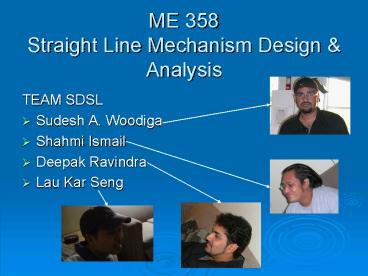ME 358 Straight Line Mechanism Design - PowerPoint PPT Presentation
1 / 23
Title:
ME 358 Straight Line Mechanism Design
Description:
?py -0.0113. 0.0937 -0.0701 -0.012 -0.118. ?px. 0. 0. 0. 0. 0. a4,2 -0.1229 -0. ... of the mechanism although its only weakness being a lack of visualization. ... – PowerPoint PPT presentation
Number of Views:1708
Avg rating:3.0/5.0
Title: ME 358 Straight Line Mechanism Design
1
ME 358Straight Line Mechanism Design Analysis
- TEAM SDSL
- Sudesh A. Woodiga
- Shahmi Ismail
- Deepak Ravindra
- Lau Kar Seng
2
ABSTRACT
- The objective of this project was to design a
crank mechanism which would translate a motor
input into a straight line output. - A grashof crank rocker was designed and mated
with a modified Roberts straight line linkage to
produce the desired output. - Analysis was done at 5 different positions
using working model and the analytical model
learnt in class. The results obtained for each
method have been tabulated separately.
3
- INTRODUCTION
4
INTRODUCTION
- After much research into the design of a
mechanism for the given requirements, we decided
that it would be best to go with a reference
approximate straight line mechanism and the one
selected was the Roberts straight line linkage. - The only shortcomings of the selected mechanism
was that it was a double rocker mechanism and
that the output it produced was an approximate
straight line. - To feed the motor input we designed a four bar
crank rocker mechanism which was mated to the
Roberts mechanism. The crank portion would
receive the motor input and the rocker mechanism
would drive the double rocker Roberts mechanism.
We also had to make sure that the point that
moves along the output path does not exceed the
specified velocity. The other problem was
producing a straight output. After much thought
and observation it was clear that the triangular
link of the Roberts mechanism had to be
lengthened in height to push the curvature in the
path of travel of the vertex of the triangular
link out and away from the 9 inch path. After
much tweaking we managed to produce an almost
perfect straight line in the 9 inch output path
with a deviation of 0.01 inches in the x-axis
path of travel, of which we think is adequate for
this design.
5
INTRODUCTION
- The next slide shows a CAD schematic of our
mechanism with the positional as well as the
packaging specifications being met.
6
INTRODUCTION
7
- ANALYSIS
8
ANALYSIS
- In deciding the scope of the analysis, the
group carried out an in depth discussion. It was
decided that the point P on the linkage being the
output path would be the focus of analysis
because it was the focus of the design, being
constrained by its required position and
velocity. - Two types of analyses will be presented, the
first being the Working Model simulation analysis
and the second being the analytical equations
method learnt in class. The equations method
will be used to cross check the results obtained
from the simulation as well as enforce the
validity of the equations method.
9
ANALYSIS (SIMULATION)
- The model of the mechanism was created in
working model and meter outputs were created
while the simulation was running to monitor the
output of the mechanism. The mechanism was
designed and modeled as 2 four bar mechanisms to
ease analysis. The output data was then copied
to Excel and analyzed to be compared with the
calculated values.
10
ANALYSIS (EQUATIONS)
11
ANALYSIS (EQUATIONS)
12
ANALYSIS (EQUATIONS)
13
ANALYSIS (EQUATIONS)
14
- RESULTS
15
RESULTS (SIMULATION)Point P
16
RESULTS (SIMULATION)Four Bar 1
17
RESULTS (SIMULATION)Four Bar 2
18
RESULTS (EQUATIONS)
19
RESULTS
- The next slide contains an animation of our
mechanism with output meters for reference.
20
RESULTS
21
RESULTS (ANALYSIS)
- After examining the tables, the results
obtained from the calculations turn out close to
those obtained from the simulation. - The results for the position, velocity and
acceleration analysis for point P clearly show
that it moves in a straight line with very slight
and almost negligible deviation in the horizontal
axis. - This verifies the validity of our mechanism as
well as the validity of the calculations method.
This reinforces the confidence of the group on
our approach to a mechanism related problem, from
a design as well as analysis point of view.
22
CONCLUSION RECOMMENDATIONS
- This project helped us apply the knowledge
gained in class to a real world problem. - The simulation method helped us form a visual
concept of the mechanism as well as making it
easier for us to see the effects of manipulating
the geometry of the mechanism on its output. - The analytical method assisted in verifying the
results obtained from the simulation method. It
also acts as a tool in which outputs can be
calculated immediately with the change of
geometry of the mechanism although its only
weakness being a lack of visualization. - The results we obtained from both methods came
out close to each other with a slight difference
due to round off errors. - We as a group feel that we have received the
optimum performance from this mechanism. We did
however come across information in the text with
regards to straight-line mechanisms. It was
stated that for a perfectly straight output to a
crank input the mechanism has to be at the very
least a 6 bar 7 joint mechanism. This would lead
to a complete redesign of our mechanism and would
increase the complexity of the analysis
performed. - Overall we feel the project has been a success
and we have applied the knowledge gained in class
to produce a satisfying outcome to a real world
problem.
23
RESOURCES
- Design Of Machinery, Robert L. Norton, Third
Edition, Mc-Graw Hill 2004 - http//www.brockeng.com/mechanism/































